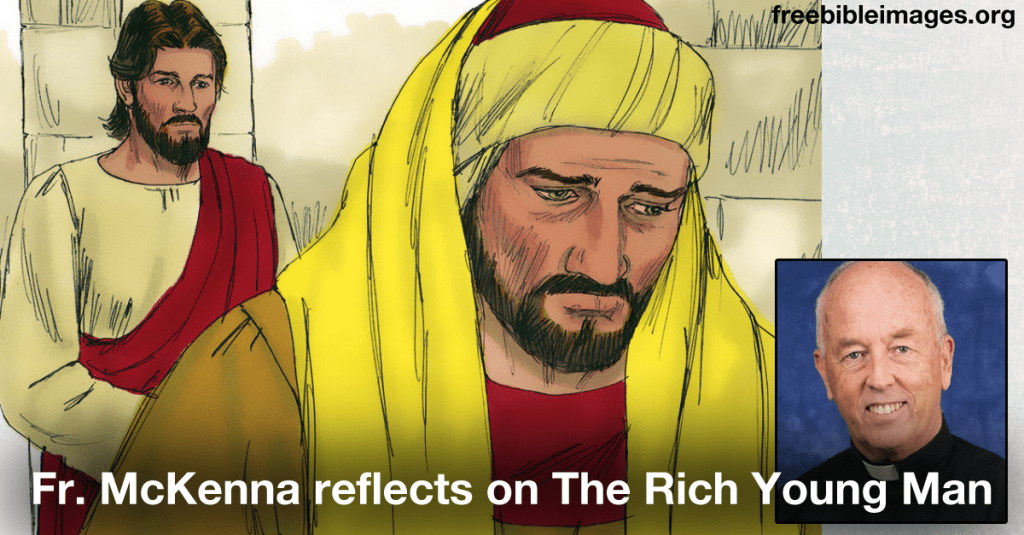
Fr. Tom McKenna reflects on The Rich Young Man (Mk. 10:17-22) and how we define ourselves in an essay “I …, Therefore I Am”
“I …, Therefore I Am”
In a philosophy class, a teacher asked, “What is your cogito?” I thought he meant some bone or other body part — but he went on to explain.
“Cogito” is Latin for ‘I think,’ as in Descartes statement, ‘Cogito, ergo sum: “I think, therefore I am.’ The fact that Descartes himself was thinking convinced him that he was real and not part of some dream.”
The professor went on, “What is it that gives you your sense of being real, of having substance? What would you put in the space before the ‘therefore I am” that gives you a sense of being anchored in life, that provides the feeling that there’s something solid inside you and not just vapor?”
His question hit, and continues to hit, a nerve. What do I need to have in order to feel I’m fully alive, grounded, that I am somebody? Or in Descartes formula, what words do I put into that blank space, “I ____, therefore I am.”
For some, it might be riches, a credit card — “I spend, therefore I am.” For others it might be being in control, or popular, or the smartest in the room, or even a victim. What are the different things I’m afraid to let go of such that if they left I’d think I’d be losing a part of my own self?
Psychologists describe this as identity. What are those grounding markers that go to make up the inner picture of my own self, elements so deeply held that were I to give them up, I’d feel like I’d be losing me? What are my “cogitos,” my identity-markers?
The question can serve as a backdrop for understanding what’s going on between Jesus and the rich young man in Mark’s account of their conversation (10:17-22). In asking him to give up his riches and follow, Jesus is touching into this man’s identity. The invitation Jesus extends fingers something so important to the young man that he feels he’d be losing a part of his own self were he to let that something go. In effect he’s saying, “I have these many possessions, and therefore I am. I’m with you Jesus right up until the point where you ask me to let go of my treasure, to give away this identity-marker. It’s an anchor that has dropped so deeply inside me that if I drew it up I fear I would just drift away. I’m afraid to let it go because I think I’d be losing something of my own self if I did.” And he walks away sad.
So the “cogito” for the young man? “I own, and therefore I am.”
But we see Jesus inviting him to make just that move, to step out beyond this one facet of his self-definition. It’s a summons to re-anchor himself — or better, to pull up one of his anchors trusting that in doing so he’d be mooring himself in a deeper ground; i.e., in the love of God shown in Jesus and Jesus’ Way. You see why the young man hesitates. What a cost. Not just the price tags on the things in his house but something connected with his very identity.
Jesus’ question echoes. What have I held onto (am I holding onto) that leaves me stuck in the young man’s shoes? What are some of those close-to-the-bone things I’ve feared letting go when I’ve heard the Lord’s bidding? Some possible answers:
“I need to…
- be right, to win, be felt sorry for,
- be in this place and doing this work,
- call the shots in my community,
- be seen as a leader,
- be taken care of with kid gloves,
- be regarded as the most effective apostle on my ministry,
- be never taken advantage of,
- be constantly consoled,
- be never lonely or taken for granted,
and therefore I am.”
Two helps from the Scriptures for making this particular discernment: Holy Wisdom and the Word of God.
Holy Wisdom, as portrayed in the Book of Wisdom, ch. 7. And that is, Wisdom as what God’s eyes see, what the world would look and feel like if I were looking at it through God’s eyes and feeling it with God’s heart. Transposed into Mark’s story, can I see myself as that rich young man?
But not so much as he sees himself but rather how Jesus sees him. “He looked at him and loved him.” Jesus saw into his heart. And so our prayer becomes, “Lord, how do I stand before you? How do you see me in my wholeness? Help me to realize what I’ve been holding on to? And, here under your loving gaze, help me let it go?”
The second comes from God’s Word as it’s so vividly imaged in the Letter to the Hebrews (4:12-13). The Word there is a laser beam that cuts between the bone and the marrow. It’s a sharp knife that lets me separate what’s true from what’s not so true. It’s “that discernment scalpel” enabling me to differentiate the different sounds coming at me and pick out the one coming from the Spirit.
We stand with the hesitant rich young man as he hears Jesus’ invitation — extended to him and to each of us through the centuries.
What is it, Lord, that I’ve been holding onto so tightly that it freezes me from taking that one further step out onto Jesus Way, Jesus’ path to his Father’s Kingdom?
Lord, let me see it. Lord, let me let it go. Lord, let me follow on Your Way.







I always struggle with this thought. Father Tom, Thank you for putting “Who am I?” into perspective.